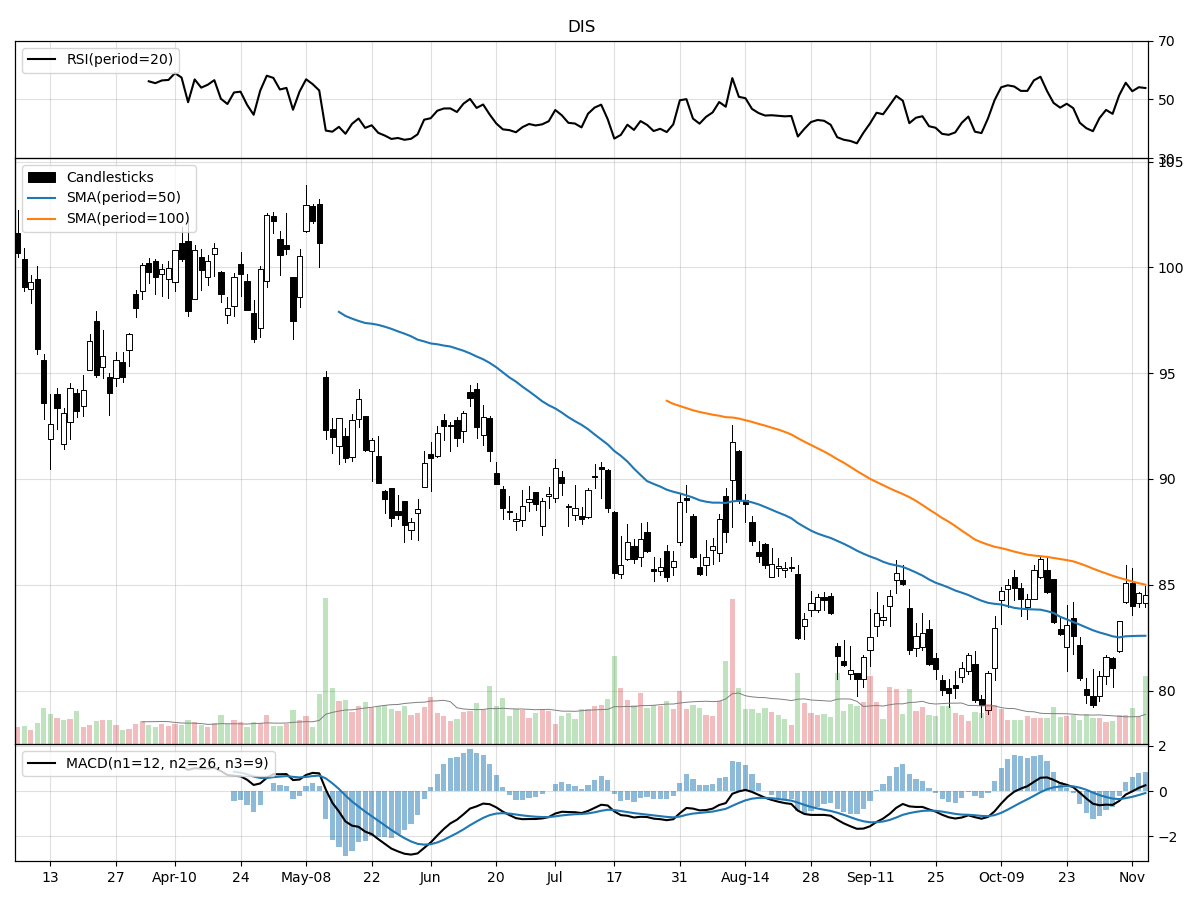The Magic of Disney

Walt Disney Co (DIS),
November 9, 2023
(AI generated investment deep dive into a company of interest)
Company Overview
Walt Disney Co is a global entertainment company operating primarily through two segments: Disney Media and Entertainment Distribution (DMED) and Disney Parks, Experiences and Products (DPEP). The DMED division encompasses global film and episodic television content production and distribution, segmented into Linear Networks, Direct-to-Consumer, and Content Sales/Licensing. It includes brands like Disney, ESPN, Freeform, FX, and National Geographic, and offers Direct-to-Consumer services such as Disney+, Disney+ Hotstar, ESPN+, Hulu, and Star+. The company's Content Sales/Licensing sector handles the sale/licensing of film and TV content, theatrical distribution, home entertainment distribution, music distribution, and the staging and licensing of live entertainment events.
Disney has recently shifted its focus towards Direct-to-Consumer (DTC) streaming services for content distribution, creating exclusive content for its platforms. This shift, accelerated by the Covid-19 pandemic, allows for flexibility in distribution strategies and can significantly affect revenues, viewership, and cost allocation across different business segments. Internationally, Disney operates general entertainment, sports, and family channels under brand names like Disney, ESPN, Fox, and Star. The company also owns equity shares in A+E and CTV Specialty Television, Inc. The key drivers for revenue and profit growth include their DTC services like Disney+ and ESPN, their sports channels, and other branded international channels. The company is also planning to increase content production for its in-house studios and create more original episodic television programs. Disney operates within a strict federal regulatory framework, most notably the regulations defined by the Federal Communications Commission (FCC).
By the Numbers
Annual 10-K Report:
- Revenue increased by 23% to $82.7 billion in 2022, compared to $67.4 billion in 2021.
- Net income rose by 40% to $3.5 billion.
- Income attributable to Disney increased by 58% to $3.1 billion.
- Service revenues increased by 20%.
- Non-cash loss of $663M due to adjustment in DraftKings Inc. investment.
- Effective income tax rate increased from 1.0% in 2021 to 32.8% in 2022.
- Disney Media and Entertainment Distribution revenue increased by 8% to $55,040 million.
- Disney Parks, Experience and Products revenue increased by 73% to $28,705 million.
- Direct-to-consumer revenues grew by 20%.
- Operating loss of over $4,015 million in Direct-to-consumer segment.
Quarterly 10-Q Report:
- Revenue for Q3 2023 was $22.3 billion, a 4% increase from the previous year.
- Net loss of $0.5 billion, compared to a gain of $1.4 billion in the previous year's quarter.
- Deficit of $134 million in income before income taxes.
- Restructuring and impairment charges of $2.65 billion.
- Revenues increased by $5.1 billion to $67.7 billion for the current period.
- Net income decreased to $2.1 billion.
- Earnings per share (EPS) reduced from $1.66 to $1.14.
- Disney Media and Entertainment Distribution (DMED) revenues fell by 1% to $14,004 million.
- Disney Parks, Experiences, and Products (DPEP) revenues rose by 13% to $8,326 million.
- Operating income for DMED decreased by 18% to $1,134 million.
- Operating income for DPEP increased by 11% to $2,425 million.
- Direct-to-Consumer subscription fees increased by 17% to $4,537 million.
- Operating loss improved by $549 million to a loss of $512 million.
- Restructuring and impairment charges increased from $34 million to $2,619 million.
Stock Performance and Technical Analysis

The current stock price of $84.5 is a crucial point of analysis. This figure is 6% above the 52-week low, indicating that the stock has been on an upward trajectory from its lowest point in the past year. However, it's also important to note that the stock is currently trading considerably lower, 81% below its 52-week high. This divergence in the stock's performance from its high and low points suggests a significant drop from its peak, which could signal a bearish trend. The stock has fallen by 0.18% over the past month, and by 2.14% over the past three months. This continuous downward trend may indicate a lack of investor confidence and could be a point of concern for potential investors.
Indicator-wise, the Moving Average Convergence Divergence (MACD) is currently bearish at -0.08. The MACD is a trend-following momentum indicator that shows the relationship between two moving averages of a security's price. A negative MACD indicates that the short-term moving average is below the long-term moving average, suggesting a downward trend and potentially a sell signal.
However, the stock is currently neither overbought nor oversold according to the Relative Strength Index (RSI), indicating a balance between buying and selling pressures. Furthermore, the Money Flow Index, which assesses buying and selling pressure by combining price and volume data, suggests that the stock is under moderate selling pressure but also under accumulation. This could imply that while there are sellers in the market, there are also buyers accumulating the stock.
In conclusion, the stock's technical indicators present a mixed picture. While there are signs of a bearish trend along with moderate selling pressure, there's also evidence of accumulation, which could imply potential upward pressure in the future. As a potential investor, these conflicting signals necessitate a cautious approach, further in-depth research, and a close monitoring of market trends and company fundamentals.

The ‘Bull’ Perspective
"Walt Disney Co. - A Resilient Entertainment Giant Worth Investing In"
Upfront:
- Despite the pandemic, Disney has demonstrated a robust financial performance, with a 4% increase in quarterly revenue.
- The company's Direct-to-Consumer strategy is showing promising results, with a 17% increase in subscription fees.
- The Parks, Experiences, and Products segment is rebounding with a 13% increase in revenues.
- The company's diverse portfolio and strong brand reputation provide a competitive edge in the market.
- The potential risks, such as COVID-19 disruptions and data security, are being strategically managed by the company.
Robust Financial Performance Amid Pandemic:
The COVID-19 pandemic has hit many sectors hard, but Disney has demonstrated resilience. The company's Q3 2023 10-Q quarterly report revealed a 4% increase in revenue to $22.3 billion, compared to the previous year. This growth was primarily driven by increased subscription revenue, theme park and resort revenues, and theatrical distribution revenue. Even though the company reported a net loss of $0.5 billion, this was largely due to a content impairment charge. The company's financial performance indicates its ability to navigate through tough times and still generate revenue growth.
Promising Direct-to-Consumer Strategy:
Disney's Direct-to-Consumer strategy is a key growth driver for the company. Subscription fees for this segment increased by 17% to $4,537 million, thanks to the growth of Disney+ Core, Hulu, and ESPN+. Despite a 24% decline in TV/SVOD distribution and other revenues, the growth in subscription fees highlights the success of Disney's strategy to focus on direct consumer engagement.
Rebounding Parks, Experiences, and Products Segment:
Disney's Parks, Experiences, and Products (DPEP) segment is showing signs of strong recovery with a 13% increase in revenues to $8,326 million. This growth is attributed to attendance growth at several resorts, indicating that consumer confidence is returning and people are willing to spend on experiences again. This rebound in the DPEP segment is a positive sign for investors.
Competitive Edge Through Diverse Portfolio and Brand Reputation:
Disney's diverse portfolio of entertainment offerings and strong brand reputation give it a significant competitive edge. Despite facing competition across all its businesses, Disney's unique intellectual properties and consumer loyalty allow it to maintain a strong market position. The company's reputation and brands are integral to its success, and any damage to these could impact sales and profitability. However, Disney has consistently managed its brand image and intellectual properties effectively, contributing to its market resilience.
Strategic Management of Potential Risks:
Disney is well aware of the potential risks it faces, such as ongoing COVID-19 disruptions, data security breaches, and changes in consumer behavior. However, the company has shown strategic foresight in managing these risks. For instance, Disney's transition to Direct-to-Consumer offerings is a strategic move to mitigate the decline in traditional distribution channels. The company is also investing in data security measures to protect its reputation and customer trust.
In conclusion, despite the challenges posed by the pandemic and other risks, Disney's strong financial performance, successful Direct-to-Consumer strategy, rebounding Parks, Experiences, and Products segment, and strategic risk management make it a compelling investment option.

The ‘Bear’ Perspective
The Case Against Investing in Walt Disney Co: A Bearish Perspective
Upfront Summary:
- Disney's Q3 2023 report shows a net loss of $0.5 billion, primarily due to a content impairment charge and increased costs.
- Despite a 4% increase in revenue, costs and expenses have also risen significantly, impacting the company's bottom line negatively.
- The company's Direct-to-Consumer segment, which includes Disney+, Hulu, and ESPN+, has seen a decline in revenue despite an increase in subscription fees.
- Disney's International Channels have seen a 20% decrease in revenue, with total revenues declining by 7% to $6,690 million.
- The company faces significant risks from the ongoing COVID-19 pandemic, changing consumer behavior, and competition.
Net Loss and Increased Costs
Disney's most recent quarterly report paints a concerning picture for potential investors. Despite a 4% increase in revenue, the company reported a net loss of $0.5 billion, largely due to a content impairment charge. This is a stark contrast to the previous year's gain of $1.4 billion. Furthermore, costs and expenses have also risen by 11% and 15% for services and products respectively, diluting the impact of the increased revenue.
Rise in Revenue but Escalating Expenses
While the company's revenue has increased by $5.1 billion to $67.7 billion, the net income has decreased to $2.1 billion, resulting in a reduction in earnings per share (EPS) from $1.66 to $1.14. This decrease in net income despite increased revenue is primarily due to the rise in expenses. The company also reported a deficit of $134 million in income before income taxes, indicating a potential issue with the company's profitability.
Direct-to-Consumer Segment Struggles
Disney's Direct-to-Consumer segment, which includes Disney+, Hulu, and ESPN+, is struggling despite a 17% increase in subscription fees. The segment saw a 24% decline in TV/SVOD distribution and other revenues, indicating that the increased subscription fees are not enough to offset the losses in other areas. The segment also reported an operating income decrease from Linear Networks by $580 million to $1,889 million from $2,469 million in Q3 2022.
International Channels Revenue Decline
Disney's International Channels have seen a significant decrease in revenue, with total revenues declining by 7% to $6,690 million from $7,189 million in Q3 2022. This decline in revenue is concerning, particularly as the company is making efforts to expand its international presence. The decline in revenue from International Channels could potentially impact the company's overall profitability.
COVID-19 and Other Risks
Disney faces substantial risks from the ongoing COVID-19 pandemic, which has disrupted operations and led to shutdowns of theme parks and resorts, delayed theatrical releases, and content production disruptions. The company also faces risks from changing consumer behavior, which could negatively affect industries like theatrical distribution, retail, and travel. Furthermore, Disney faces substantial competition across all its businesses, which could impact its market share and profitability.
In conclusion, while Disney's revenue has increased, the rise in costs and the decline in net income are concerning. The challenges facing the company's Direct-to-Consumer segment and the decline in revenue from International Channels further add to these concerns. Given these factors, along with the significant risks posed by the ongoing COVID-19 pandemic and competition, it may be prudent for investors to hold off on buying Disney stock at this time.



Comments ()